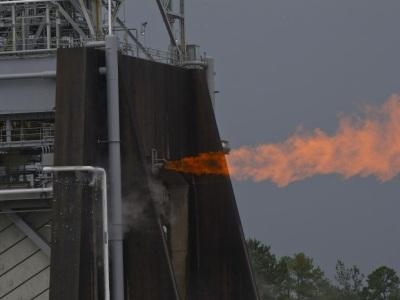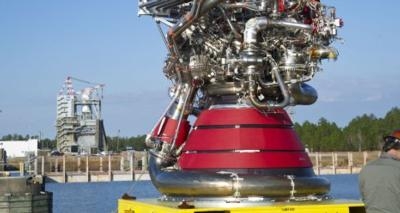Fri, Apr 26, 2013
Pratt & Whitney Rocketdyne Completes J-2X Hot Fire Testing
The last in a series of hot-fire tests on a J-2X engine with a stub-nozzle extension at simulated altitude conditions has been completed by Pratt &Whitney Rocketdyne. This latest chapter in the development of America's next rocket engine paves the way toward full-motion testing of the J-2X engine, which is designed to power humans to Mars. NASA has selected the J-2X as the upper-stage propulsion for the evolved 143-ton Space Launch System (SLS), an advanced heavy-lift launch vehicle.

"This test series with the stub-nozzle extension was very successful," said Walt Janowski, J-2X program manager, Pratt & Whitney Rocketdyne. "We completed all the objectives we set out to accomplish, and acquired important information to help us better understand how the engine will perform during flight – from thrust, hardware durability and combustion stability. We look forward to continuing to work with NASA to provide a safe, reliable transportation system to explore new destinations in space."
In the latest series of tests with the stub-nozzle extension, J-2X Engine 10002 was tested six times for a total of 2,156 seconds on the A-2 test stand at John C. Stennis Space Center in Mississippi. The stub-nozzle extension allows engineers to test the engine in near-vacuum conditions, similar to what it will experience in the extreme environment of space. The next step is to move the engine to the A-1 test stand, where it will be fired to test the range of gimbal motion for its flexible parts. Engine 10002 is the second J-2X development engine built by Pratt & Whitney Rocketdyne for NASA.
The first J-2X engine, Engine 10001, was tested a total of 21 times for more than 45 minutes last year. The J-2X powerpack, which consists of components on top of the engine, was tested separately 13 times for a total of more than 100 minutes at Stennis Space Center. The engines and powerpack were fired at varying pressures, temperatures and flow rates to ensure the engine is ready to support exploration beyond low-Earth orbit, Mars and beyond.
(Images provided by NASA)

More News
Also: Netherlands Donates 18 F16s, 2 737s Collide On Ramp, E-7 Wedgetail Cut, AgEagle's 100th In S Korea The Pilot and Aircraft Privacy Act was introduced in the House by Represent>[...]
Pilot Also Reported That Due To A Fuel Leak, The Auxiliary Fuel Tanks Were Not Used On June 4, 2025, at 13:41 eastern daylight time, a Piper PA-23, N2109P, was substantially damage>[...]
Have A Story That NEEDS To Be Featured On Aero-News? Here’s How To Submit A Story To Our Team Some of the greatest new stories ANN has ever covered have been submitted by our>[...]
From 2023 (YouTube Edition): Reflections on War’s Collective Lessons and Cyclical Nature The exigencies of war ought be colorblind. Inane social-constructs the likes of racis>[...]
What Goes Around, May Yet Come Back Around, Klyde FMI: www.klydemorris.com>[...]
 Airborne 06.30.25: US v ADS-B Misuse, Natl STOL Fire, Volocopter Resumes
Airborne 06.30.25: US v ADS-B Misuse, Natl STOL Fire, Volocopter Resumes NTSB Prelim: Piper PA-23
NTSB Prelim: Piper PA-23 ANN FAQ: Submit a News Story!
ANN FAQ: Submit a News Story! Classic Aero-TV: One Mans Vietnam
Classic Aero-TV: One Mans Vietnam Klyde Morris (06.30.25)
Klyde Morris (06.30.25)




